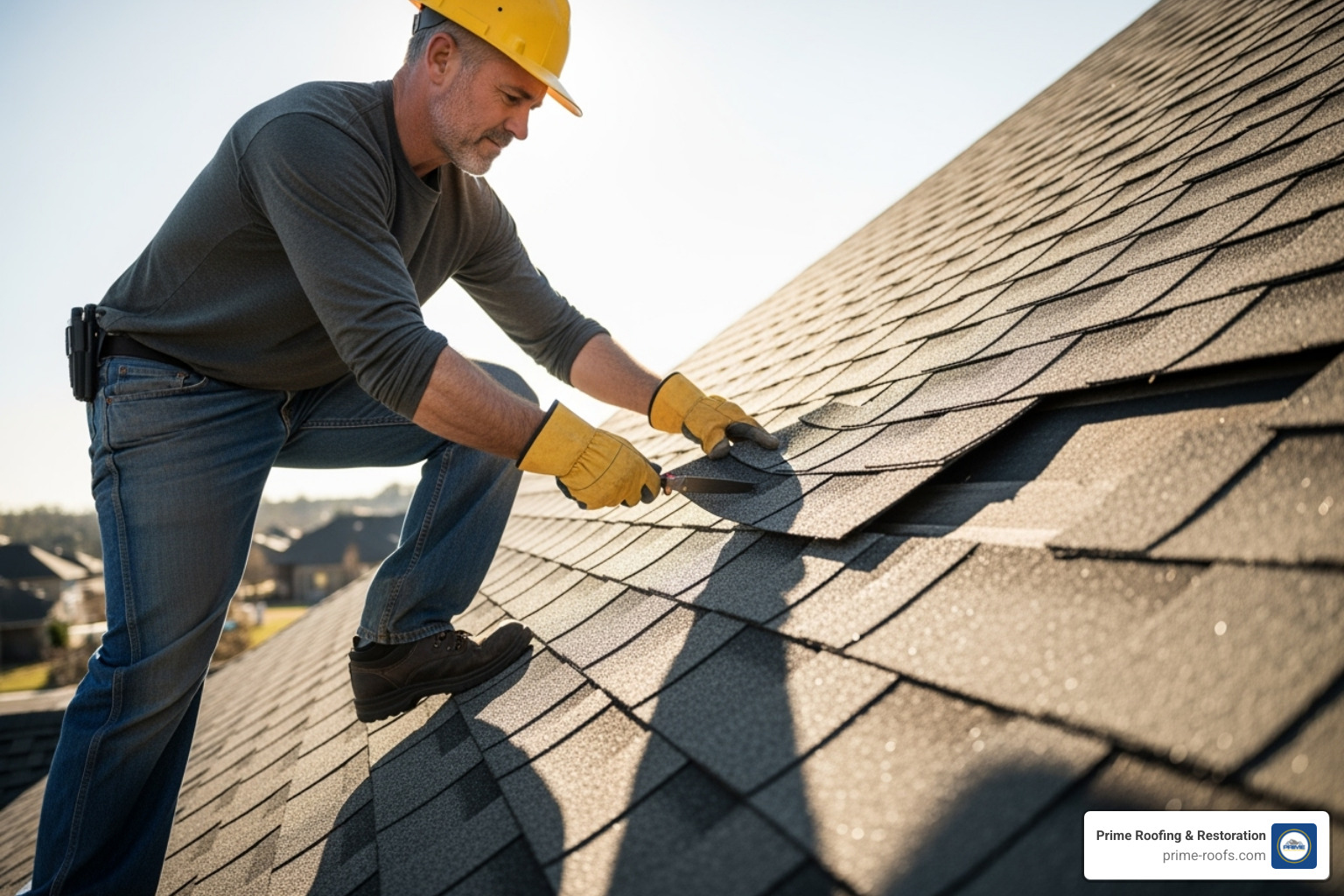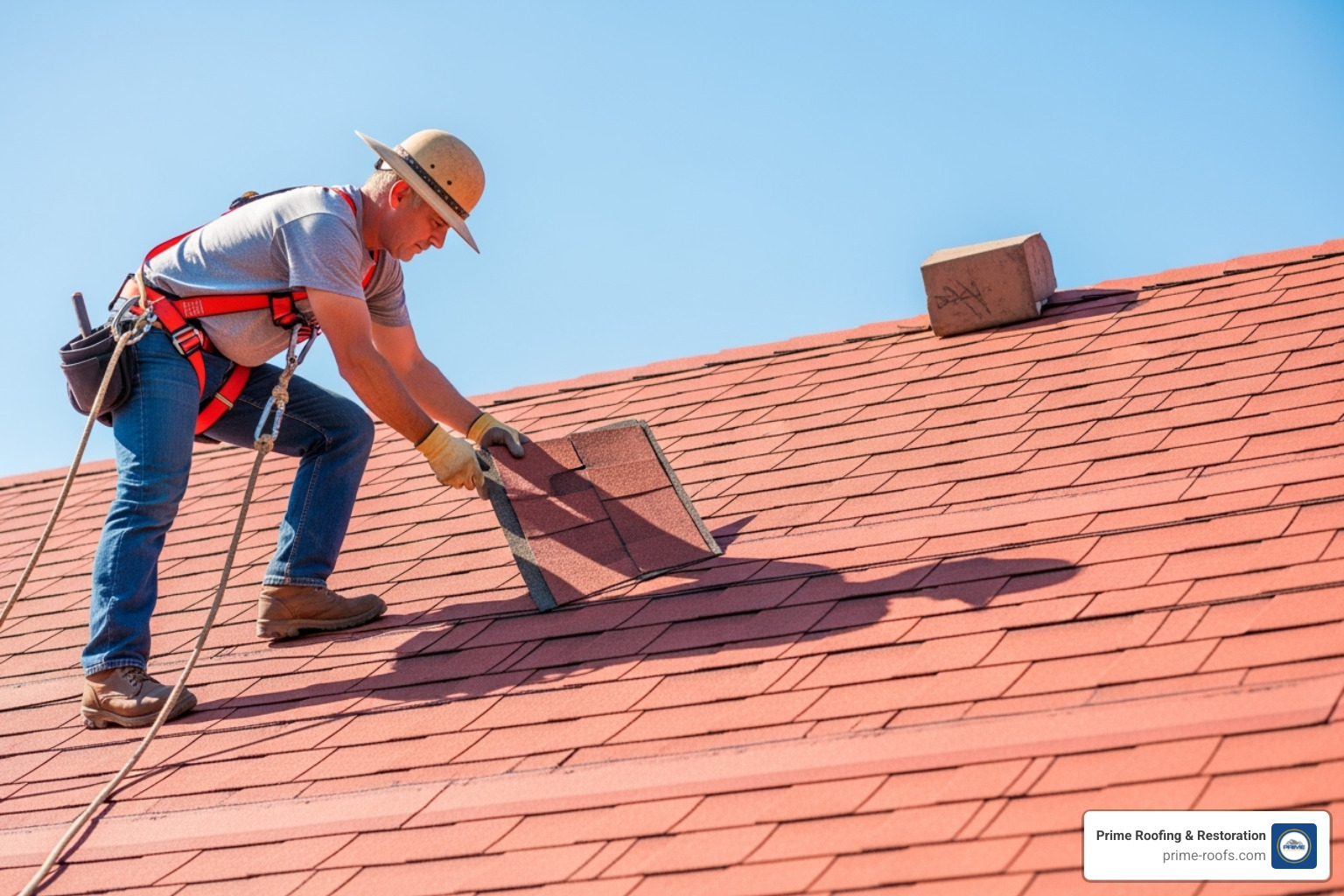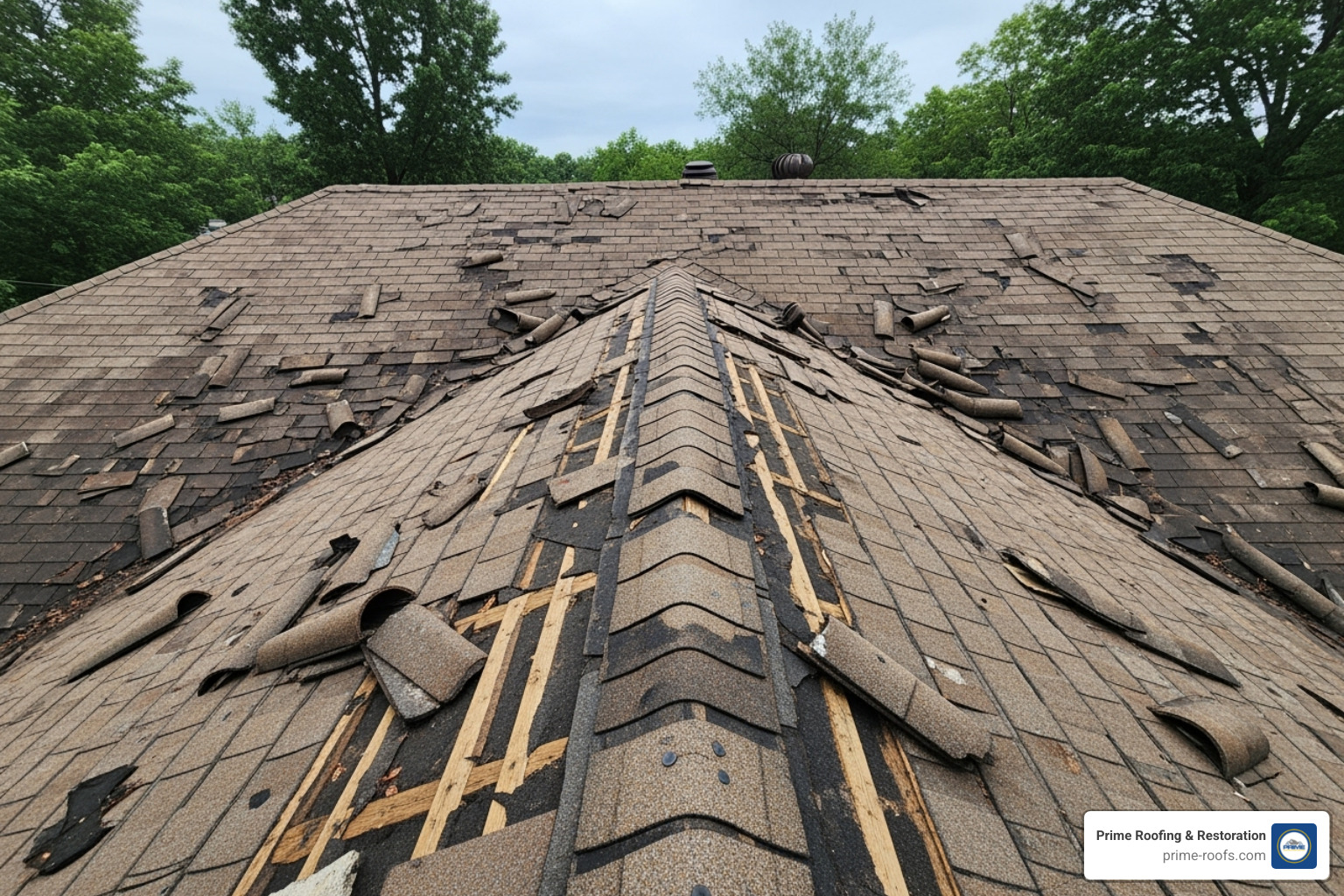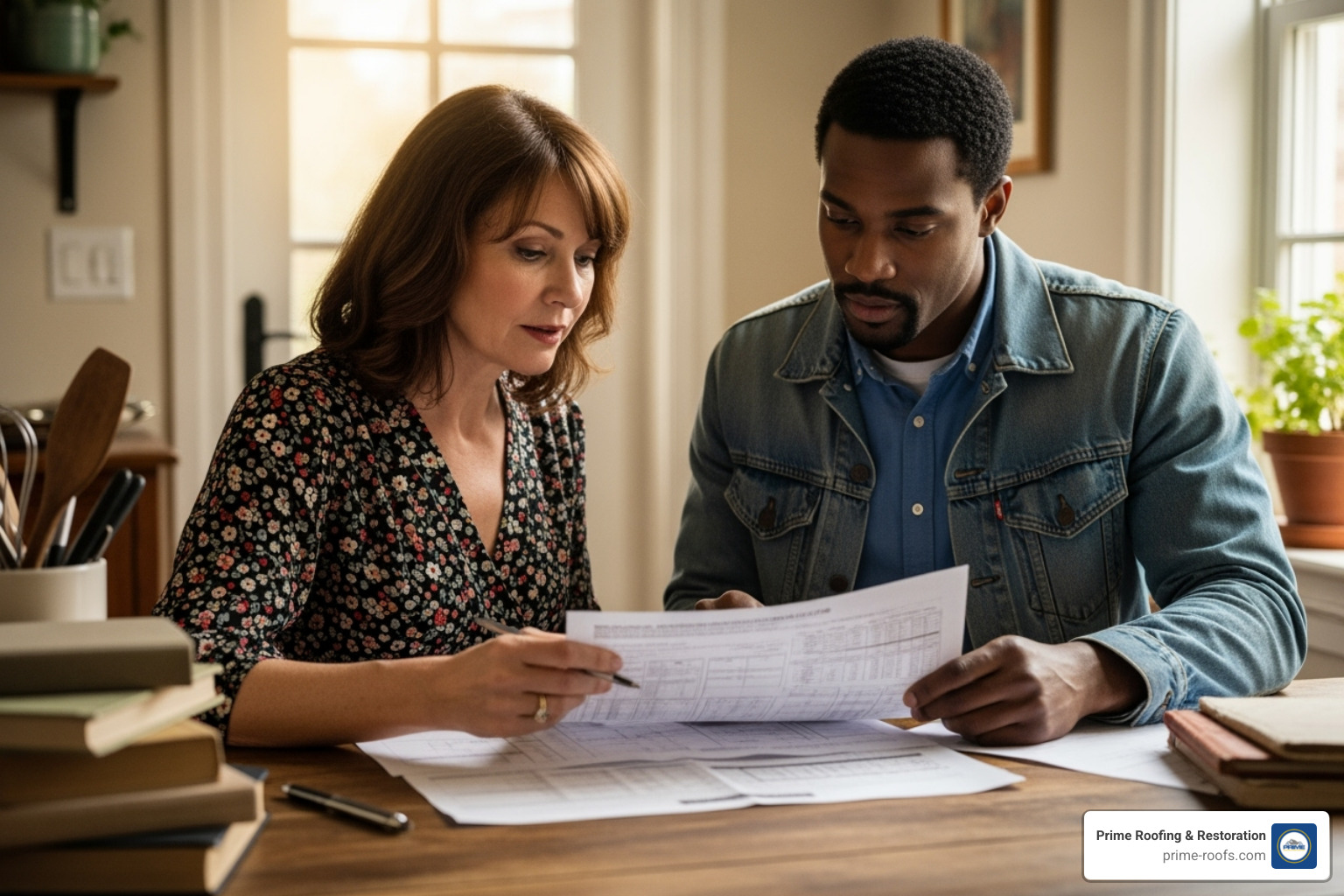The Importance of Your Roof Repair Estimate
Your roof is the unsung hero of your home, quietly shielding everything you love from Alabama’s unique and often harsh weather. When you notice a missing shingle or a dark spot on the ceiling, it’s natural to wonder how serious the problem is and how much it will cost. Before we dive in, you can always turn to our experienced Alabama roofing company for guidance, free estimates, and fast service. From the relentless, blistering sun of a Gulf Coast summer that can bake shingles brittle, to the sudden, violent thunderstorms that roll in with little warning, your roof bears the brunt of it all. When that vital protection shows signs of trouble—a missing shingle, a dark spot on the ceiling—the first question is always, “How much is this going to run me?” In the next few minutes, we’ll break down the numbers behind a professional roof repair estimate so you can budget with confidence. If you simply need trusted professional roof repair for a fast, honest quote, Prime Roofing & Restoration has you covered. Understanding the costs now empowers you to act quickly, prevent costly water damage, and keep small issues from ballooning into five-figure headaches.
What is the Average Cost of a Roof Repair?
When you spot damage overhead, understanding the potential cost is the first step toward a smart decision. Nationally, roof repair costs can range from a few hundred dollars for simple fixes to several thousand for extensive damage. Alabama pricing is influenced by factors like our intense sun, heavy rain, and occasional hurricanes, which can affect the type and severity of repairs needed.
Because labor represents a significant portion of the bill, even a small fix carries a base charge for the service call. Below are the three cost tiers you’ll usually encounter.
Average Costs for a Minor Roof Repair Estimate

Minor issues are the most affordable fixes that prevent major headaches. This category includes tasks like replacing a handful of shingles (up to a 10’x10′ area or about 25 shingles) that were blown off in a storm, resealing the flashing around a chimney or vent pipe that has started to separate, or swapping out a single cracked plumbing vent boot. These are often problems you can spot from the ground. Addressing them promptly is the key to keeping repairs in this affordable zone.
Costs for Moderate Roof Repairs
When problems are more complex, you enter the moderate repair range. This could involve addressing a persistent leak that requires a more in-depth investigation to find the source. It often includes replacing a small section of damaged underlayment or decking beneath the shingles. Tricky valley repairs, where two roof planes meet and channel large amounts of water, also fall into this category, as they require precision to rebuild correctly. If you’re dealing with storm damage, our quick guide on what to do after a storm damages your roof will help you act fast and limit costs.
Costs for Major Roof Repairs
Major work involves the most significant investment and addresses serious issues that compromise the roof’s structural integrity. Examples include repairing large sections of rotted or sagging roof decking, addressing extensive water damage that has spread to the rafters or attic, or fixing widespread flashing failure along dormers or roof-to-wall transitions. When repair estimates for an older roof (20+ years) become substantial, it’s crucial to weigh the cost against a full replacement, which may offer better long-term value and peace of mind.
Before signing anything, schedule a professional inspection. We provide free, no-obligation estimates to help you make an informed decision.
Decoding Your Roof Repair Estimate: Key Cost Factors

When you open a roof repair estimate, several line items drive the total:
- Pitch & accessibility – The slope, or pitch, of your roof is a major cost driver. A low-slope, easily walkable roof is straightforward to work on. However, a steep-pitched roof (anything over a 6/12 pitch) requires specialized safety equipment like harnesses, roof jacks, and sometimes even scaffolding. This increases labor time and the inherent risk, which is reflected in the price.
- Location & permits – Local labor rates vary across Alabama, and city or county permit fees can add to the total. Check specific requirements for Alabama municipalities in this roofing permits information resource, as they can impact both cost and project timeline.
- Extent of damage – What you see on the surface isn’t always the whole story. A few missing shingles might be hiding a patch of saturated, rotting plywood decking underneath. A professional roofer will do their best to assess this during the inspection, but the full extent is sometimes only revealed after the old materials are torn off. These hidden issues are the biggest wildcards in any repair estimate.
- Season & demand – After a major storm or hurricane, demand for qualified roofers skyrockets. During these peak times, labor rates can increase, and you may have to wait longer for service. Planning non-emergency repairs for the off-season can sometimes lead to cost savings.
How Roofing Materials Impact Repair Costs
| Material | Relative Cost | Life Span | Complexity |
|---|---|---|---|
| Asphalt Shingles | $ | 20-30 yrs | Low |
| Metal Panels | $$ | 40-70 yrs | Medium |
| Slate | $$$ | 75+ yrs | High |
| Clay/Concrete Tile | $$$ | 50-100 yrs | High |
Understanding Labor and Overhead
The hourly rate for professional crews in Alabama isn’t just for the time spent on your roof; it covers essential overhead like travel, vehicle maintenance, worksite setup, safety equipment, liability and worker’s compensation insurance, and thorough cleanup. These are the critical costs that DIY attempts often overlook.
Are There Hidden Costs?
A transparent contractor will build contingencies into their discussion, but some costs genuinely can’t be known until the work begins. The most common surprise is rotted decking, which will add to the material and labor costs. Other potential finds include damaged flashing around chimneys or skylights, compromised fascia boards from overflowing gutters, or even mold in the attic insulation. It’s wise to budget an extra 10-20% of the estimate for these potential surprises. A reputable roofer will communicate these possibilities upfront and use a change order to document and approve any additional work needed.
Roof Repair vs. Full Replacement: Making the Right Call

Deciding between a significant repair and a full replacement is a critical financial decision. If damage covers more than 30% of your roof’s surface or your roof is 20+ years old, replacement often delivers better long-term value and safety than repeated patches. Insurance carriers also frequently lean toward replacement for older systems with extensive, storm-related damage, as patching becomes inefficient.
When to Opt for a Roof Repair
Repair is the logical choice for a relatively young roof (under 15 years old) with isolated, specific problems. If you have a few missing shingles from a windstorm, a leak around a single vent pipe, or damage confined to one small area, a targeted repair is efficient and cost-effective. A focused repair that reliably extends your roof’s life by another five solid years is a smart financial move, especially when a full replacement isn’t in the immediate budget. The key is that the rest of the roof system is still in good condition.
When a Full Roof Replacement is Necessary
Sometimes, a repair is just a temporary, money-wasting patch on a failing system. If your roof is over 20 years old (approaching the end of its typical lifespan), has widespread issues like curling or balding shingles across multiple sections, or suffers from persistent leaks that reappear after repairs, replacement is the wiser long-term investment. Other red flags include structural sagging, visible rot in the decking from the attic, or if the cost of repairs exceeds 30-50% of the cost of a new roof. Furthermore, finding matching shingles for an older, discontinued style can be impossible, making a cohesive repair aesthetically unpleasing and pushing the decision toward a fresh start. Curious whether your roof is sending those signals? Review our guide on 5 signs you need roof replacement for a quick self-check.
How to Get a Reliable Estimate and Hire a Reputable Contractor

Finding a trustworthy contractor is just as important as the estimate itself. Follow these steps to ensure you get rock-solid quotes and quality workmanship:
- Get Multiple Written Estimates: Always aim for at least three detailed, written estimates from different licensed and insured roofing companies. This allows you to compare not just the final price, but the proposed scope of work.
- Verify Credentials and Reputation: Don’t just take their word for it. Confirm they have a current Alabama state license and carry both general liability insurance (to protect your property) and worker’s compensation insurance (to protect you from liability if a worker is injured). Check their reputation on sites like Google, Nextdoor, and the Better Business Bureau. A long-standing local presence is a great sign.
- Compare Apples to Apples: The lowest bid isn’t always the best. Scrutinize each estimate. Are they all proposing to use the same quality of materials? Is the warranty offered the same? Does one include replacing flashing while another plans to reuse the old flashing? A thorough estimate will detail materials, labor, cleanup, and warranty terms.
- Insist on a Detailed Contract: Never proceed with work based on a verbal agreement. A professional contract should clearly outline the full scope of the project, materials to be used, start and end dates, total cost, and payment schedule. Read it carefully before signing.
Be wary of red flags like high-pressure, door-to-door sales tactics, a lack of a permanent local address, or demands for full payment before any work begins.
DIY vs. Hiring a Professional
The temptation to save on labor costs by tackling a roof repair yourself is understandable, but it’s fraught with risk. Beyond the obvious safety dangers of working at height, a DIY repair can go wrong in many ways. You might use the wrong materials, install them incorrectly (leading to worse leaks), or fail to spot underlying damage. Furthermore, a DIY job comes with no warranty, and you could even void your roof’s existing manufacturer warranty. Professionals bring years of experience, the right safety gear, specialized tools, and crucial insurance coverage. Most importantly, they provide a workmanship guarantee, giving you peace of mind that the job is done right.
Navigating Insurance Claims
If your roof damage is from a storm, your homeowner’s policy may cover it. Document all damage with clear photos and videos before any work is done. File your claim promptly and keep a detailed record of every receipt and all communication with your insurer. An experienced contractor who is familiar with insurance procedures can be an invaluable asset, helping to meet with the adjuster and ensuring all covered damage is properly documented and included in the claim.
Reduce Long-Term Costs With Simple Maintenance
Proactive maintenance is the best way to avoid expensive, unexpected repairs. Simple actions like semi-annual inspections (from the ground or by a pro), keeping gutters clean and free-flowing, trimming overhanging tree branches, and addressing minor issues promptly can save you thousands over the life of your roof. A professional inspection and tune-up is a small price to pay to prevent catastrophic water damage.
Frequently Asked Questions about Roof Repair Estimates
How long does a roof repair take?
Minor fixes, like replacing a few shingles or sealing a vent, can often be completed in 2–4 hours. Moderate work, such as repairing flashing or a small section of underlayment, might take a full 1–2 days. Major structural repairs can span several days, and timelines can sometimes be extended by weather delays.
Should I get multiple estimates?
Absolutely, yes. Obtaining at least three detailed, written quotes is a crucial step. It allows you to compare not just the price, but the contractor’s understanding of the problem, the proposed solution, the quality of materials, and the included warranties. This diligence helps prevent misunderstandings and costly surprises down the road.
Can a small leak really cause expensive damage?
Unfortunately, yes. A small, seemingly insignificant leak is one of the most deceptive and dangerous roofing problems. Water can travel along rafters and behind walls, silently saturating underlayment, decking, insulation, and drywall. By the time you see a stain on your ceiling, what could have been a simple patch job may have already ballooned into thousands of dollars in structural repairs and professional mold remediation. It is critical to act fast at the very first sign of water intrusion.
What kind of warranty should I expect for a roof repair?
For repairs, you should expect a workmanship warranty from the contractor, typically ranging from 1 to 5 years. This covers the quality of the installation and any leaks that might occur in the repaired area. This is separate from the material warranty provided by the shingle manufacturer. Be sure to get the terms of the workmanship warranty in writing.
Your Next Steps for a Secure Roof
A clear roof repair estimate puts you in control—no guessing, no sticker shock. Addressing issues early keeps costs in the minor-repair range and preserves your home’s value.
Prime Roofing & Restoration offers free inspections and written estimates throughout Central and Southern Alabama. With 24/7 emergency service available, we’re ready to help when you need it most. For your free estimate, call (205) 661-8190 to schedule a free inspection, or book an appointment through our online contact page at a time that works best for you. Let our team restore your roof’s strength before the next storm rolls in.
